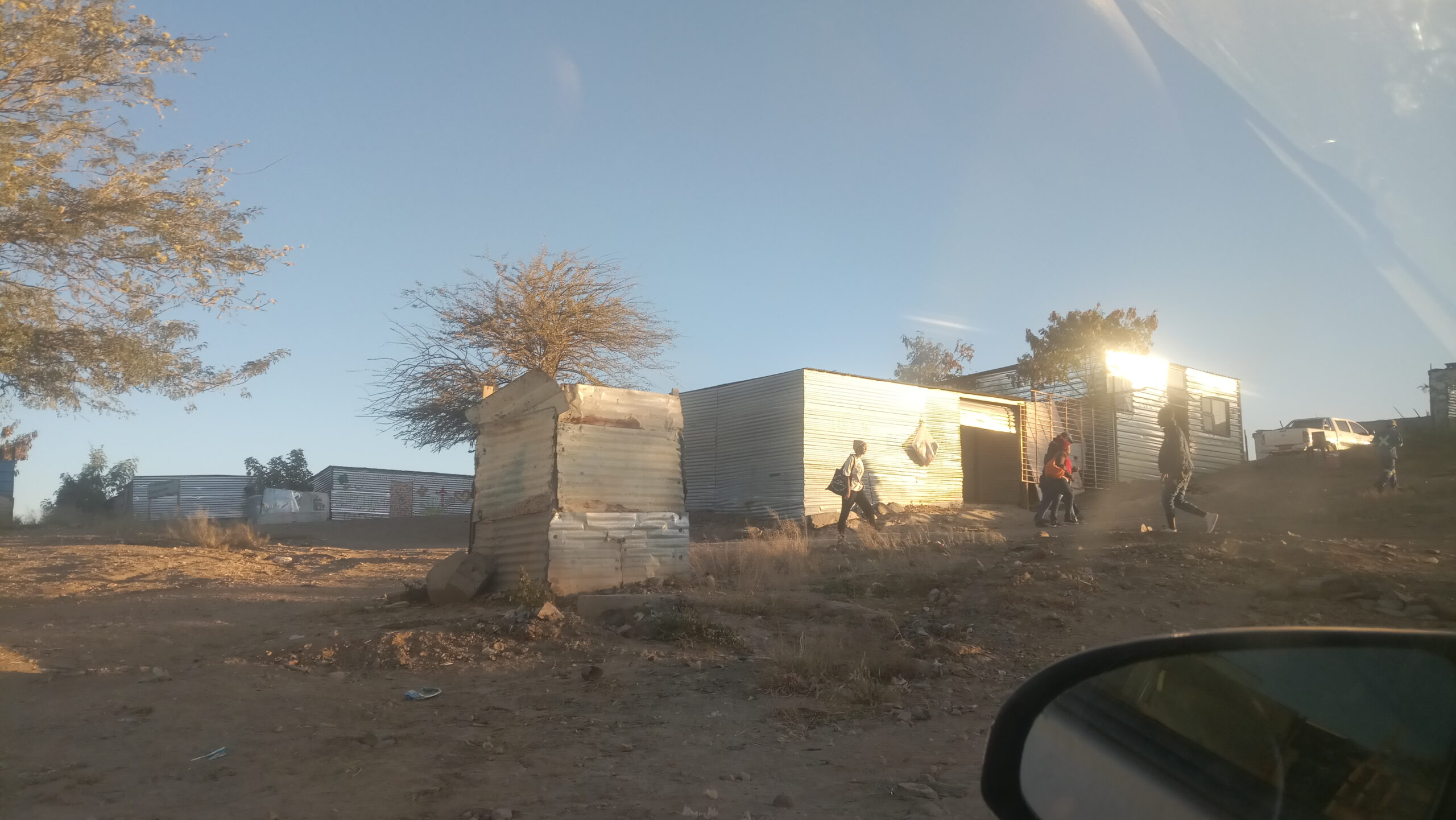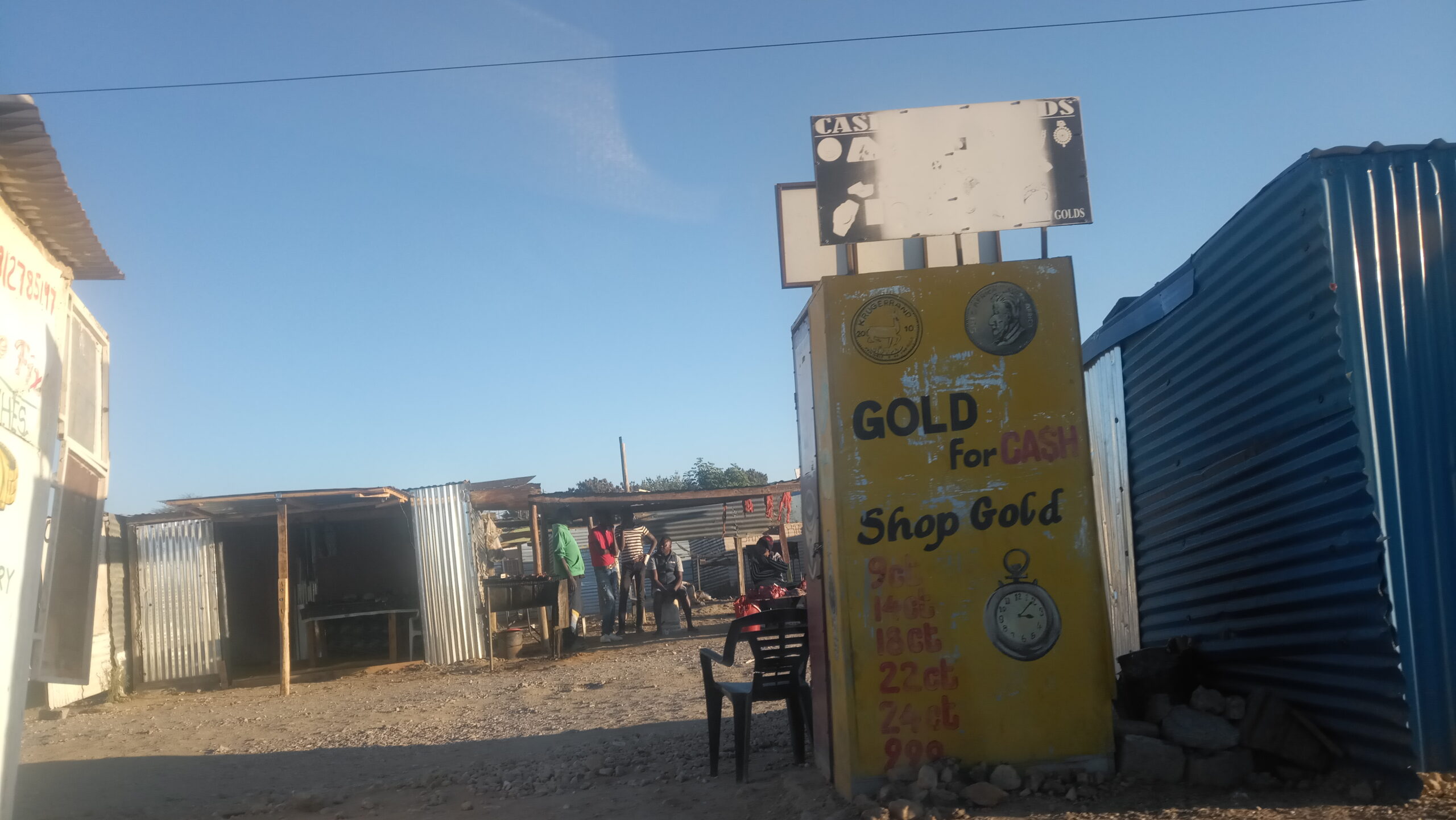In June 2023, Andy Gheorghiu, a German-based and internationally operating campaigner and consultant for climate/environmental protection and energy policy, travelled to Namibia, where he met members of the local Economic and Social Justice Trust in the capital Windhoek. While visiting the township of Katutura, he witnessed the harsh economic reality of a post-apartheid democracy but also identified its huge transformative potential.

Katutura, Windhoek, June, 2023. Copyright: Andy Gheorghiu, All Rights Reserved.
Katutura or „The place where people don’t want to live“
The township of Katutura was created during the apartheid regime of South Africa in 1961. The black population of Windhoek, nowadays Namibia’s capital, was forced to move from an area called the Old Location, to Katutura, which means “The place where people do not want to live” or “We do not have a permanent habitation” in the language of the Herero people.
The initial township had brick houses but these days the majority of its housing, businesses, shops and pubs are tin shacks which often lack reliable access to water, sanitation and electricity.
The 2023 population of Windhoek is estimated at roughly 477,000 – compared to 19,500 in 1950. A growing number of residents are forced to live in the tin shacks of Katutura – creating a severe housing crisis and social injustice that has been addressed and debated by the Namibian Journal of Social Justice. These informal settlements are increasingly growing especially in developing countries – including African countries. According to research by the Department of Agricultural Economics, Extension and Rural Development, University of Pretoria, South Africa, 40% of Namibia’s 2.41 million population were living in shacks in 2018. According to a 2011 census, Katutura had a population of almost 27,000 thousand people in an area of 2,500 km². The population density was 10,600 inhabitants per km2. In comparison, Berlin’s population density stood at 4,100 people per km² in 2020.
Given Windhoek’s fast pace of population growth in recent years, these numbers are now likely to be even higher. No one can deny the precarious living conditions of the – only black – people forced to live in a place where they – still – lack a permanent dwelling. However, this place also demonstrates huge transformative potential.

Katutura, Windhoek, June2023. Copyright: Andy Gheorghiu, All Rights Reserved.
First of all, Katutura is far cleaner than a number of grubby areas in Berlin. Secondly, people are really trying to make the best of a situation that is uncomfortable and at times almost unbearable. I saw businesses, shops, pubs and fast food places, reflecting the pride of people who refuse to lose their dignity. Thirdly, the most abundant free energy source of the world, the sun, blesses the city of Windhoek with an annual average of 3,610 sunshine hours, which is roughly 9.9 hours of sunshine per day, more than twice Berlin‘s average and even higher than that of Los Angeles in the Sunshine State of California. This extensive sunshine obviously provides huge potential for solar power development.
Namibia’s climate risk profile and vast renewable energy potential
The World Bank Group in 2021 analysed and outlined the Climate Risk Profile of Namibia. Among other nations, it highlighted it as “highly vulnerable to seasonal variability and long-term climate change” adding that “increasing vulnerability is expected to result in cumulative impacts across the country’s social, economic, and environmental structures”.
At the same time, the country’s potential for renewable energy is yet to be harvested.
According to the Global Photovoltaic Power Potential by Country (a report provided by the World Bank in 2020): “Namibia has the highest average practical PV power potential of all countries, and it is twice as high compared to the United Kingdom, a country with one of the least generous conditions for PV.”
The German GIZ (Deutsche Gesellschaft für Internationale Zusammenarbeit) collated statistics for Namibia in its 2022 “Sector Brief Namibia: Renewable Energies”.
According to this report, due to its unusually high annual solar radiation, PV systems Namibia can produce twice as much electricity as similar systems in Germany. Yet, at present, the electricity rate is at only 56% and 60% of that power is being imported, mainly from South Africa. In rural areas, only 35% of the population has access to electricity and nationwide some 300,000 households have no access to electricity. Namibia plans to expand its power plant capacities to over 1,600 MW by 2035 -with over 700 MW (or 60%) coming from planned renewable energy. Currently, the country has an overall power plant capacity of 516 MW – with a peak demand of over 600 MW.
Shipping Containers and the Sun – transformative powers for Katutura and Namibia?
Repurposed shipping containers are being used as accommodation units for construction workers or labour camps, and they’re also increasingly trendy as affordable and alternative homes.
These living containers are quite modular and there are online instructions how to even construct your individual housing by using an old shipping container – which are cheaper than fabricated living containers you can order. Available plug & play photovoltaic systems can be mounted quickly and easily on every container – which could power the living container and maybe also feed centralized or decentralized grids.
The sun shines on average almost 10 hours/day in Windhoek and Katutura covers an area of 250,000 hectares. For comparison, the ten-hectare solar project Outapi in Northern Namibia produces 9,000 MWh of energy/annum. In a possible future, fully equipped living containers could replace the existing tin shacks in the township of Katutura, potentially even producing enough energy to feed Windhoek’s electricity needs.

This raises the question: Why adopt living containers instead of “proper” brick houses? Opting for living containers would be a fairly cheaper and faster way to replace tin shacks quarter by quarter in Katutura. This in turn, would improve the living conditions of thousands of people in Windhoek.
The sun shines all year long and the people of Katutura seemed to me ambitious enough and ready for the challenge of an initiative that could end up being a transformative and powerful flagship project for other townships. People could tackle the housing and energy crisis while providing social and climate justice at the same time.
Looking ahead political will and investment are key to unlocking a solar future for Namibia, the world’s number one country in terms of its photovoltaic potential. One consideration would be to make it mandatory for companies seeking licenses for large renewable energy projects to pay into a state-managed fund which would help finance such projects. Countries such as Germany, who have the ambition of being global climate leaders should support Namibia by providing expertise, technology, and funding. Germany already supports Namibia in urban planning in the area of green hydrogen production – aimed at feeding Germany’s heavy industry. The country should stand by its commitment for “projects in sustainable urban development, vocational training, climate change adaptation, as well as the protection of biodiversity and improved water supply” to help Katutura become a transformative Namibian social and energy powerhouse.

Katutura, Windhoek, June 2023. Copyright: Andy Gheorghiu, All Rights Reserved.